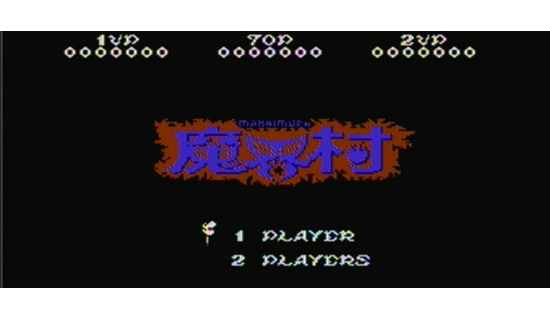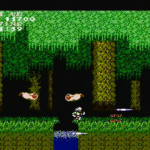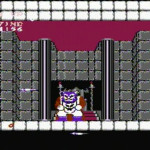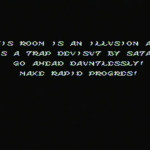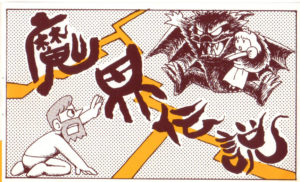Despite its high level of difficulty, Makai Mura was an arcade success. And in these days of console gaming, that meant a port to home consoles would be highly sought after. It was generally accepted that (for the most part) because console hardware was still very young it probably wasn’t advanced enough to look, sound and feel like it was an arcade game. As long as it captured the essence of the original though, that was usually good enough. The Famicom was no longer a young system in June 1986, at least not in Japan. It had seen its share of arcade ports by this time, and quality had been all over the board. Capcom (who was at this point still a fairly young company) had only had two of its arcade titles ported to the Famicom at this point though: 1942 and Son Son. Unfortunately, neither of them were very good ports at all.
Like the two previously mentioned titles, a ghost developer called Micronics developed Makai Mura on the Famicom as well. It would also be the last Famicom game that they ported for Capcom. When it comes to game play and controls, this port is not terribly far off. But it misses out on just about everything else. The graphics took a very noticeable hit from the original, but that isn’t completely unprecedented when going from arcade to Famicom. The rich organ and keyboard sounds of the original are also poorly represented here, and what we get is constantly being interrupted on a sound channel by the sound of Arthur’s weapon being thrown. A better choice would really be to just turn down the volume and listen to something else, instead of this tinny and interrupted rendition of an originally good soundtrack (see also Micronics’ previous ports for a case of the exact same thing). The scrolling is noticeably choppy by comparison, and the key to being able to play the arcade version well is completely thrown out the window here: The enemy patterns.
The enemies just don’t behave the same way at all here, and sometimes this work out for better, sometimes not. Zombies in particular seem to spawn in batches here, and you get a lot less time to react before taking a hit as they first start appearing. This results in a feeling of being overwhelmed by enemies that wouldn’t necessarily have overwhelmed you in the original, such as zombies and the burrito knights. Even the previous tricks to ground Red Arremer no longer work, but that actually makes him easier to handle. All you need to do here is walk away from him, wait for his swoop, and jump and fire. Go to the other side and repeat. Still though, it’s basically having to learn the game all over again.
But maybe the worst part of this port is that certain bosses were given complete resistance to certain weapons, something not present whatsoever in the arcade version (unless you count requiring the cross to be able to proceed to the last boss). The Unicorn (first and second bosses) is immune to the cross, the Dragon (third and fourth bosses) to the lance, and Satan (fifth and six bosses) to the axe. This adds a very non-trivial extra layer of difficulty, since you have to be lucky enough to get the appropriate weapon to drop before you reach a specific boss, though this really only starts to become a problem if you haven’t picked up a different weapon by the time you reach the third level boss. It makes the sixth stage, in which you have the pleasure of fighting each of the previous bosses back to back, truly hellish.
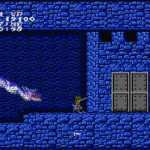 | 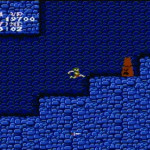 |
| The third and fourth level boss: the Dragon. You can’t damage this guy with the lance in this version! | A tower enemy that looks a bit like Kool-Aid Man?! |
This port is also just very glitchy in general. Partway through the first level, you encounter your first Red Arremer (made famous by the early Makai Mura episode of Game Center CX). In this version, you can actually hit him and immediately run back off screen. If performed correctly, you’ll activate a glitch that will make him just disappear. If performed incorrectly, you’ll find Arremer wickedly dancing toward you, forcing you to face him.
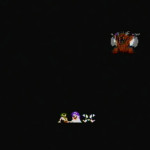 | 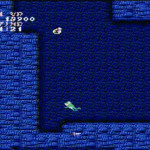 |
| Don’t you hate it when you’re lounging around in your underwear with your girlfriend, and Satan just appears? | Arthur can also be turned into a frog if you pick up the wrong item! |
For as janky as this game is though, it does represent a milestone for the Famicom: This is the first 1 megabit cartridge. The next would also be Capcom’s own “Senjou no Ookami”, or “Commando”.
The US release on the NES really only contains one act of censorship. The cross weapon was changed to a shield, not surprising given Nintendo of America’s aversion to religious imagery at this time. You might think that they would have replaced the instance of “Satan” in the fake ending text, but that isn’t the case.
If you specifically want to own the Famicom/NES port, your options are the original cartridge, the Famicom Mini/Classic NES release on the Game Boy Advance, or the Virtual Console release on Wii, 3DS or Wii U in any territory. I’d highly recommend the original arcade version in one of its many forms instead, unless you have a strange affection for this version specifically.
(The following are scans of some of the amusing art found in the instruction manual of the Famicom version)
